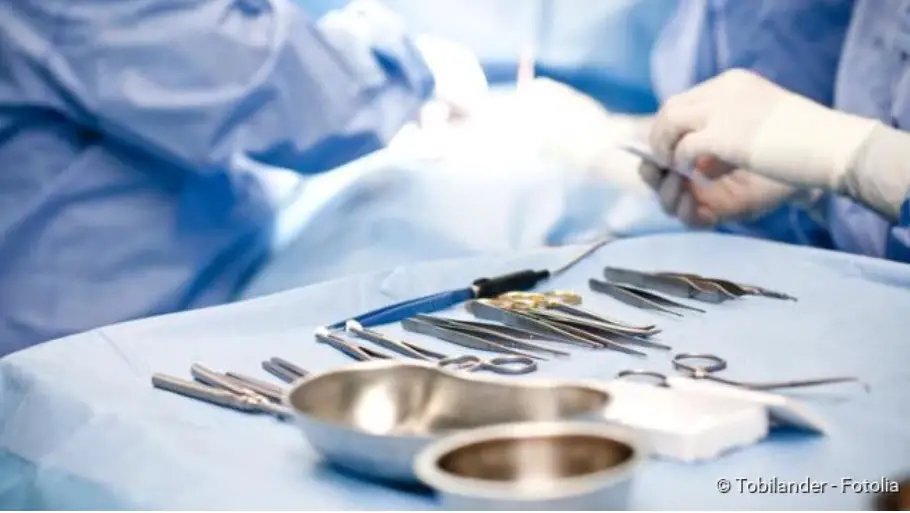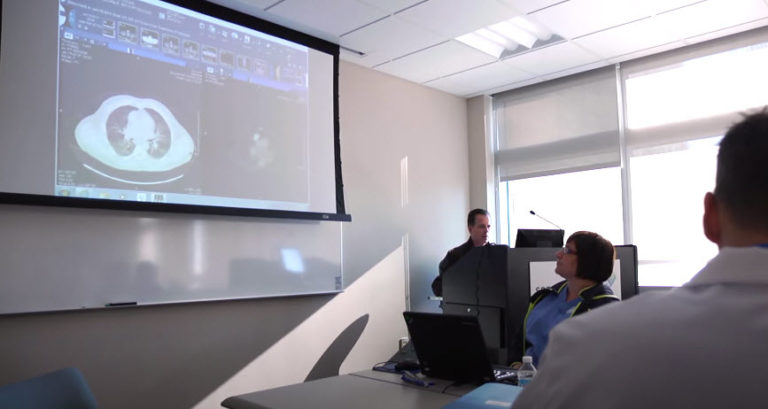Intestinal obstruction: causes, warning signs, symptoms, treatment
Intestinal obstruction: causes, warning signs, symptoms, treatment
In the case of an intestinal obstruction (medical ileus) the intestine actually closes up. Food remains can hardly or not at all get through. This can have various reasons, but is always an emergency that must be treated immediately in hospital! Common warning signs of intestinal obstruction are abdominal pain, nausea and vomiting (of faeces). Here you will learn what can cause an intestinal obstruction, how to recognise it and what the doctor can do to restore intestinal function.

Brief overview
- What is a bowel obstruction? Complete or partial blockage of the bowel passage; technical term: ileus
- Causes: Mechanical obstacles such as tumours, scarring, intestinal entrapment in the case of inguinal hernia etc., paralysis or cramping of the intestinal wall
- Symptoms: somewhat different depending on cause and severity, but usually abdominal pain, nausea and vomiting, bloated abdomen
- Treatment: Empty the intestine by stomach tube, supply of nutrients and fluid by infusion, medication (painkillers, remedies against nausea and vomiting, antibiotics etc.); if necessary, surgical removal of the obstacle, artificial intestinal outlet
- Investigations: Patient interview (anamnesis), physical examination, imaging procedures (X-ray, ultrasound, computer tomography if necessary)
- Prognosis: intestinal obstruction is always an emergency! The earlier he is treated, the better the chances of survival.
Intestinal obstruction: Description and causes
In the case of an intestinal obstruction (ileus), the passage through the small or large intestine is completely interrupted. The preliminary stage of the ileus is called subileus. This is a clinically not yet fully developed intestinal obstruction.
If the intestine can no longer pass its contents through as usual, an optimal breeding ground for bacteria is formed there. If they enter the bloodstream, there is a risk of blood poisoning (sepsis). Due to the accumulation of food residues and gas formation, the intestine expands strongly. Its wall becomes thin and prone to cracks and holes. Escaping intestinal contents can lead to peritonitis (inflammation of the peritoneum).
At the same time, if the intestine is blocked, it can no longer release important blood salts (electrolytes) and fluid into the bloodstream. A deficiency is developing which can be dangerous.
Intestinal obstruction: causes and risk factors
An intestinal obstruction can have various causes. In principle, the following main groups of ileus can be distinguished:
- mechanical bowel obstruction: bowel obstruction caused by a mechanical obstacle; most common form of ileus
- functional bowel obstruction: bowel obstruction due to a disorder of the bowel muscles. This includes primarily the paralytic ileus (cause: paralysis of the intestinal muscles). A spastic ileus (cause: cramping of the intestinal muscles) rarely occurs.
A mechanical ileus can turn into a combined mechanical-paralytic bowel obstruction without treatment.
Mechanical ileus
A mechanical intestinal obstruction can be caused, for example, by a constriction of the blood vessels supplying the intestine (strangulationsileus). This can happen, for example, in an inguinal hernia when a piece of intestine is trapped in the hernial orifice (incarceration). However, strangulationsileus can also result when the intestine rotates on its own axis (volvulus) or when a piece of intestine slips over the following intestinal section (invagination).
In other cases, mechanical bowel obstruction is caused by a displacement of the intestinal lumen, for example by a foreign body, worms or a tumour (such as colon cancer). Hard faeces can also clog the intestine (more precisely: colon). In rare cases, a large gallstone is the obstacle: In the so-called gallstone ileus, the wall of the gall bladder collapses into the adjacent small intestine. This creates a direct connection (fistula) with the intestine. A large gallstone can pass over these and either block the small intestine itself or the transition from the small to the large intestine (ileocecal valve).
Sometimes a mechanical intestinal obstruction is due to a narrowing of the intestinal lumen from the outside. A possible cause is adhesions in the abdominal cavity as a result of inflammation or surgery. Such adhesions are called “Briden”, which is why one speaks here also of a Bridenileus. Tumours in the abdominal cavity can also press on the intestine in such a way that the intestinal passage is hindered or interrupted. This can happen, for example, when the peritoneum is flatly affected by cancer (peritoneal carcinomatosis).
Sounding bowel noises, also known as peristalsis, are often heard when the bowel is strongly pressed from the outside. They occur when the food pulp is pressed with pressure through the reduced intestinal lumen.
Pathological processes in the intestinal wall such as chronic inflammatory bowel diseases (Crohn’s disease, ulcerative colitis) or inflamed intestinal protrusions (diverticulitis) are also possible reasons for mechanical bowel obstruction.
Paralytic ileus
In contrast to mechanical intestinal obstruction, in paralytic ileus there is no obstacle blocking the further transport of the food, but rather a paralysis of the intestinal muscles.
This paralysis can be the result of vascular occlusion, for example due to locally formed blood clots (thrombi). In this case experts speak of a primary paralytic ileus. More frequent is the secondary paralytic ileus: Here, the intestinal muscles are paralyzed by mechanical stimuli, for example by an operation or severe abdominal diseases (such as peritonitis or appendicitis).
You can read more about the causes, signs and treatment of intestinal obstruction due to paralysis of the intestinal wall in the article Paralytic ileus.
Spastic ileus
An intestinal obstruction due to a cramping of the intestinal wall is rare. It can be the result of lead poisoning. Certain metabolic diseases, which are summarized under the term porphyria, are also possible causes. Sometimes spastic intestinal obstruction is also caused by an infection with roundworms (ascariasis).
Intestinal obstruction in infants
Even babies can get an intestinal obstruction. On the one hand, a section of the intestine may be closed from birth (intestinal atresia). On the other hand, the first tough stool of the newborn (meconium) can clog the intestine. Doctors call this a meconium ileus. The meconium consists, among other things, of hair, skin and mucous membrane cells swallowed in the uterus.
A meconium ileus is usually an early indication of a congenital metabolic disease, cystic fibrosis.
Intestinal obstruction: symptoms
Not all bowel obstructions are the same. Not only do the causes differ, but the symptoms also vary depending on the cause and severity of the bowel obstruction.
Mechanical intestinal obstruction: Symptoms
Intestinal obstruction symptoms in the mechanical type are:
- severe, cramp-like (colicky) abdominal pain, which increases and decreases in waves
- acute wind and stool conditions
- Nausea and vomiting
- distended stomach
- increased intestinal wind (flatulence)
- Burping
- accelerated heartbeat
- Fever
With strangulationsileus the affected intestinal section is no longer supplied with blood. The pain is then permanent. In addition, blood pressure drops, the pulse accelerates and those affected vomit heavily – in extreme cases even faeces (vomiting).
Paralytic intestinal obstruction: Symptoms
Symptoms of intestinal obstruction in the paralytic type are less pronounced and occur with delay. Nausea and vomiting do indeed torture the patient in this form as well. However, since the intestine is paralyzed, no intestinal sounds can be heard. In this context, doctors also speak of a grave or deathly silence. The pain is not intermittent as in mechanical intestinal obstruction. Instead, they are persistent and diffuse – those affected cannot clearly describe where it hurts. Particularly pronounced is the bloated abdomen, which can become a hard, tense “drum belly” in the event of additional peritonitis. In the later course, the affected person may vomit liquid intestinal contents.
Location of the ileus influences symptoms
Furthermore, the symptoms differ according to where the intestinal obstruction occurs. The higher it is located in the intestine (for example in the initial part of the small intestine), the earlier and more strongly the affected person vomits. With a deep-seated intestinal obstruction, the symptoms begin more slowly (insidiously) with loss of appetite, feeling of fullness, nausea and growing abdominal girth. In the further course of the disease, vomit may break out.
Intestinal obstruction is an acute emergency! Whatever symptoms occur – those affected must see their doctor immediately. Without therapy the ileus almost always ends fatally!
Intestinal obstruction: Treatment
An intestinal obstruction is an acute emergency and must be treated in hospital!
The therapy depends on what has caused the intestinal obstruction and where in the intestine it occurs. Often conservative measures are sufficient. In any case, the patient must refrain from eating and drinking for the time being. He is usually given a stomach tube to drain the backed up intestinal contents. In addition, an infusion is made to introduce nutrients, fluid and, if necessary, medication (e.g. for nausea and vomiting) directly into the bloodstream. To control the amount of urine delivered, the doctor may place a bladder catheter.
Other conservative measures that may be useful in the case of intestinal obstruction include enemas, warm and humid abdominal compresses and the administration of medication to stimulate intestinal peristalsis.
Surgery is absolutely necessary in the case of strangulation uleus as well as in the case of a colon obstruction. If an operation is not possible, he will place an artificial anus (anus praeternaturalis, stoma).
After the operation, the patient receives an infusion for several days. It is only after the first bowel movement that one slowly begins to get the bowel moving – first with tea, then with liquid and later with passed food. After about ten days, easily digestible food in the form of rusks, bananas or potatoes is finally allowed.
Intestinal obstruction: examinations and diagnosis
If an intestinal obstruction is suspected, the doctor will ask the patient in detail about his medical history (anamnesis): Among other things, he will ask when the symptoms have been present, where exactly the pain occurs, when the last time stool and intestinal wind came out and whether the patient has had any abdominal surgery.
This is followed by a physical examination: the doctor palpates the patient’s abdomen and checks whether the abdominal muscles are tensed reflexively by the touch (defensive tension). In addition, the abdomen is monitored with a stethoscope. This may give an indication of the type of intestinal obstruction. If intestinal noises are heard, this rather indicates a mechanical intestinal obstruction. In contrast, the absence of intestinal sounds (“grave/dead silence in the abdomen”) is probably a paralytic ileus.
The physical examination in the case of intestinal obstruction also includes the doctor palpating the rectum with a finger via the anus (rectal examination).
An ileus can be visualized by means of an X-ray examination. Only four to five hours after the start, the X-rays show bloated intestinal loops containing fluid. If a colon obstruction is suspected, the patient often receives an enema with a contrast medium before the X-ray. On the pictures you can see where exactly the shutter is located.
The doctor can also often discover the exact location of the intestinal obstruction by ultrasound. There are standing intestinal loops and sometimes free fluid in the abdomen as well as large gas accumulations.
In certain cases, computed tomography (CT) may be useful, for example if tumours are suspected or as preparation for surgical treatment.
Intestinal obstruction: course of disease and prognosis
The earlier an intestinal obstruction is detected, the better it can be treated. Without treatment it can become life-threatening, for example if the intestinal wall breaks through (perforation), if an inflammatory reaction (blood poisoning = sepsis) occurs due to bacterial toxins in the bloodstream and causes circulatory or multi-organ failure, or if the lack of fluid and electrolytes in the body leads to shock.
Because the chyme remains in the intestine, the pressure on the intestinal wall increases dangerously. The sensitive mucous membrane can be injured (mucous membrane erosion). As a consequence, even parts of the intestinal wall can die off (intestinal wall necrosis). Bacteria can then migrate through them and cause peritonitis – another life-threatening complication of ileus.
The mortality rate for intestinal obstruction is five to 25 percent. Every hour that passes without treatment increases the risk of death by about one percent.
Intestinal obstruction: Prevention
If you want to prevent an intestinal obstruction, you should above all pay attention to a regular bowel movement. A diet rich in fibre in the form of lots of fruit, vegetables and wholefood products is recommended. Fibre stimulates the activity of the intestines. An adequate fluid intake (1.5 to 2 litres per day) and regular exercise are also important for a regular digestion.
After an abdominal operation, adhesions sometimes form in the abdominal cavity, which can cause an ileus. Anyone who has undergone abdominal surgery should therefore pay particular attention to possible signs of intestinal obstruction (abdominal pain, lack of bowel movement, etc.) and, if necessary, see a doctor early on.





